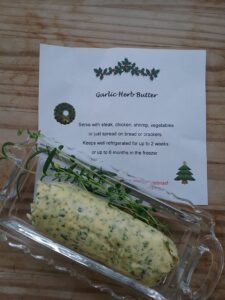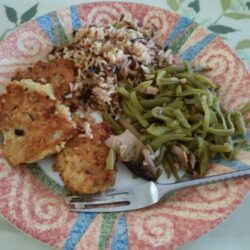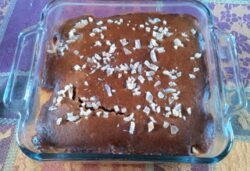C.D. Hersh's Blog, page 73
March 9, 2021
Wednesday Special Spotlight Garlic Herb Butter Topping
My niece JJ is an excellent and creative cook. This past Christmas she gave me a roll of garlic herb butter that is to die for. Not only is great on cooked steak and veggies, it’s delicious spread on crackers. Of course, I had to make another batch right after the holidays because we devoured her amazing gift in a flash. I am confident you and yours will like this recipe, too.
½ cup butter at room temperature2 garlic cloves, crushed
1 tsp fresh rosemary or ½ tsp. dried, chopped fine
1 tsp. fresh thyme or ½ tsp. dried, chopped fine
2 tbsp. fresh parsley or 1 tbsp. dried, chopped fine
Cream butter in a medium sized bowl with a spoon. A handheld mixer works too.
Stir in garlic and herbs until just blended.
Tear off 6 – 7 inches of wax paper. Lay butter about 1½ inches from the edge. Use your fingers to shape into a log about 1 inch thick. Cover log with that bit of extra paper and roll, shaping the log as you go. After butter is wrapped, twist the ends tightly.
Refrigerate at least 2 hours before serving.
Herb butter lasts 2 weeks in the fridge and up to 6 months in the freezer.
Oregano and basil are excellent replacements for rosemary and thyme.
May you enjoy all the days of your life filled with good friends, laughter, and seated around a well-laden table!
Sloane
 Sloane Taylor is an Award-Winning romance author with a passion that consumes her day and night. She is an avid cook and posts new recipes on her blog every Wednesday. The recipes are user friendly, meaning easy.
Sloane Taylor is an Award-Winning romance author with a passion that consumes her day and night. She is an avid cook and posts new recipes on her blog every Wednesday. The recipes are user friendly, meaning easy.
Learn more about Taylor’s cookbooks, Date Night Dinners and Recipes to Create Holidays Extraordinaire on Amazon.
Excerpts from her romance books and free reads can be found on her website, blog, and her Amazon Author Page. Connect with Taylor on Facebook and Twitter.
March 8, 2021
Tell Again Tuesday Voices in the writers head
THE SIGNS YOUR DRAFT NOVEL IS TRYING TO COMMUNICATE WITH YOUBy Lucy Mitchell
To the writer their draft novel is a living thing. It communicates with them regularly, even when they are trying to avoid it. A draft novel senses when the writer is ready to write and it knows when the writer is actively trying to avoid it.
Once you start delving into this strange phenomenon of unspoken communication you will see why a writer’s life is so exhausting.
With so much unspoken communication going on between the writer and their draft novel it’s a wonder the writer has . . .
For the rest of the blog go to:March 4, 2021
Friday Feature Shot Weed in the Writing Garden
The warm days this week enabled us to take a stroll through the yard, another put-our-butts-in-the-writing chair avoidance tactic. We found a slew of winter weeds scattered throughout the landscape. Some tiny-leafed, prostrate thing has taken over a portion of the easement making it the greenest it has been in years. Buckhorn plantain spills out between the path stepping stones. Flat rosettes of chickweed carpet the stone gully in the backyard, and henbit, with its scalloped leaves and purple stems, juts out of the grass—or at least what passes for grass in the lawn.
We’re letting the unidentified weed taking over the easement and the lawn. It’s green, low growing, and doesn’t look like it would need much mowing. But after an afternoon of surfing weed identification web sites (another avoidance tactic), we’ve come to the conclusion that we might have to dig out this patch of weeds and eradicate it every other spot we find. You see, if we’ve identified it correctly, we’re harboring shot weed, also known as hairy bittercress. Oh, it looks innocent enough, but when it sets seeds the slightest touch will send hundreds of seeds shooting out in a three foot radius across the lawn into flowerbeds and pathways looking spots to hide and root.
Fighting weeds in the garden is a full time task. It starts in early spring with digging out winter weeds like plantain, chickweed, and henbit from the paths and flower beds. By the time we get those eradicated the dandelions rear their yellow heads. After that it’s pigweed and purslane and nutsedge and Canadian thistles and Jimson weed and ground ivy and goose grass. Spring and summer progress marked by an army of weeds marching through the garden. We hoe and pull and mulch and spray, and they just keep coming. The only thing that keeps them under control is persistent daily effort—and maybe a hard, hard freeze.
Like the cycle of weeds in the garden, writers face different challenges along every stage of our careers. As soon as we think we have a handle on our craft and profession something new springs up and surprises us. The beginning writer’s weeds might be learning the basics of the craft or finding that story idea or dealing with writer’s block. For some it’s getting to the end of the book, or figuring out what to do with the sagging middle. For the more skilled, unpublished writers the weeds that need pulling could be social networking, getting an agent, or getting published. Whatever the weeds in your writer yard there’s one universal truth—they will always be there. Our job is to figure the best way to control them.
We’re not a beginning writers. We know how to write. That has been reinforced with a number of contest placements. We have a good grasp of the skills and have been published. We know our stories and the characters. We even have books waiting in the wings to be written. But we still have writing weeds to pull—BIG ones.
We haven’t finished our series—yet.We want to write in several genres, which presents branding problem and sometimes an identity crisis.
While we have some social networking and internet connections there isn’t a large following wanting our books—one of the biggest weeds for a lot of writers.
Currently, we spend more time blogging than writing the books.
Gertrude Jekyll, one of the most important British landscape designers and writers, once said, “There is no spot of ground, however arid, bare or ugly, that cannot be tamed into such a state as may give an impression of beauty and delight. It cannot always be done easily; many things worth doing are not done easily; but there is no place under natural conditions that cannot be graced with an adornment of suitable vegetation.”
Gertrude’s advice applies not only to the garden, and all those weedy patches, but to writing as well. The road to success isn’t easy, but we can accomplish it. We can transform those bare, ugly pages into something overflowing with suitable vegetation (the best words and story we can make). When we finally reach that goal it’s worth the work. So, pull those weeds out of your writing garden and create something beautiful!
We’re going to try this year to get rid of our biggest weed and finish our next book.
What are the writing weeds that are stopping you from creating your masterpiece? Do you have a plan to pull them out?
While you figure out what weeds to attack here’s an excerpt from the first book in our series.
Blurb for—The Promised One
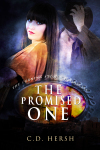 In the wrong hands, the Turning Stone ring is a powerful weapon for evil. So, when homicide detective Alexi Jordan discovers her secret society mentor has been murdered and his magic ring stolen, she is forced to use her shape-shifting powers to catch the killer. By doing so, she risks the two most important things in her life—her badge and the man she loves.
In the wrong hands, the Turning Stone ring is a powerful weapon for evil. So, when homicide detective Alexi Jordan discovers her secret society mentor has been murdered and his magic ring stolen, she is forced to use her shape-shifting powers to catch the killer. By doing so, she risks the two most important things in her life—her badge and the man she loves.
Rhys Temple always knew his fiery cop partner and would-be-girlfriend, Alexi Jordan, had a few secrets. He considers that part of her charm. But when she changes into a man, he doesn’t find that as charming. He’ll keep her secret to keep her safe, but he’s not certain he can keep up a relationship—professional or personal.
Danny Shaw needs cash for the elaborate wedding his fiancée has planned, so he goes on a mugging spree. But when he kills a member of the secret society of Turning Stones, and steals a magic ring that gives him the power to shape shift, Shaw gets more than he bargained for.
EXCERPT:
The woman stared at him, blood seeping from the corner of her mouth. “Return the ring, or you’ll be sorry.”
With a short laugh he stood. “Big words for someone bleeding to death.” After dropping the ring into his pocket, he gathered the scattered contents of her purse, and started to leave.
“Wait.” The words sounded thick and slurred . . . two octaves deeper . . . with a Scottish lilt.
Shaw frowned and spun back toward her. The pounding in his chest increased. On the ground, where the woman had fallen, lay a man.
He wore the same slinky blue dress she had—the seams ripped, the dress top collapsed over hard chest muscles, instead of smoothed over soft, rounded curves. The hem skimmed across a pair of hairy, thick thighs. Muscled male thighs. Spiked heels hung at an odd angle, toes jutting through the shoe straps. The same shoes she’d been wearing.
The alley tipped. Shaw leaned against the dumpster to steady himself. He shook his head to clear the vision, then slowly moved his gaze over the body.
A pair of steel-blue eyes stared out of a chiseled face edged with a trim salt-and-pepper beard. Shaw whirled around scanning the alley.
Where was the woman? And who the hell was this guy?
Terrified, Shaw fled.
The dying man called out, “You’re cursed. Forever.”
Amazon buy links for all the books of the series:
The Promised One (The Turning Stone Chronicles Book 1)
Blood Brothers (The Turning Stone Chronicles Book 2)
Son of the Moonless Night (The Turning Stone Chronicles Book 3)
The Mercenary and the Shifters (The Turning Stone Chronicles Book 4)
Links for our other books are on our book page or under the menu at the top of the post.
March 2, 2021
Wednesday Special Spotlight a C.D. Hersh family #recipe
CALICO FUDGE
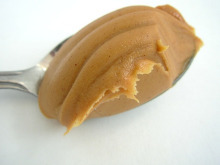 ⅔ cup milk
⅔ cup milk1½ cups granulated sugar
¾ cup brown sugar
Pinch of salt
2 tbsp. butter
4 tbsp. peanut butter
12 marshmallows, cut into pieces
Cook milk, sugars, and salt to soft ball stage. Remove from heat.
Add butter and peanut butter. Beat until creamy.
Lay marshmallows one inch apart in a greased pan. Pour fudge over the marshmallows.
Cut into squares when cold.
Here is a little about our paranormal series, The Turning Stone Chronicles .We hope you enjoy it.

Three ancient Celtic families. A magical Bloodstone that enables the wearers to shape shift. A charge to use the stone’s power to benefit mankind, and a battle, that is going on even today, to control the world. Can the Secret Society of shape shifters called the Turning Stone Society heal itself and bring peace to our world? Find out in the series The Turning Stone Chronicles series.
Links for our other books are on our book page or under the menu at the top of the post.
March 1, 2021
Tell Again Tuesday The Publishing Road Map
ANOTHER PATH TO GETTING PUBLISHEDBy Kim Findlay
When we as writers think of being published, there are two obvious routes to follow.
One is to get an agent and be published traditionally. The problem with this option is that so much of the process is out of our hands: querying to find an agent who likes our work, waiting for a submission to be selected, publishing date, etc.
The other is to self-publish. For this you have to learn to format, do cover art and blurbs, and all your own marketing. Most of us writers tend to be introverts who have imposter syndrome on a regular basis, so promoting ourselves is really difficult. And if you’re like me, your technical skills are…limited.
As of the end of 2021, I will have eight books traditionally published, and I don’t have an agent. That’s a third option you . . .
For the rest of the blog go to:February 25, 2021
Friday Features #recipe from the “C” of C.D. Hersh
As the “C” of C.D. Hersh I do the cooking around the homestead. Today I thought it would be nice to share a homey meal of salmon patties. This is my mother’s recipe, and quite frankly, I love it so much that I always put a few patties aside for breakfast. I even eat them cold. As kids, and when I could eat more carbs, these were served with white rice and gravy made from the oil and pan drippings. Nowadays I choose a more carb friendly side. I know the “D” loves these and I hope you’ll enjoy them too.
1 – 15 oz. can of pink salmon2 eggs, lightly beaten
½ cup finely diced onion
1 cup finely diced celery
¼ cup yellow cornmeal
1 – 2 tbsp. vegetable oil
Drain salmon, leaving bones and skin in bowl. Add eggs and veggies and mix well. Add cornmeal and mix well.
Heat oil in skillet until it shimmers. Form patties using a 2-inch diameter spoon and fry in oil until golden brown on both sides. It may take 2 batches to cook all patties and you may need to add a bit more oil as they fry. Keep patties warm in a low temperature oven while your second batch cooks.
Makes 12 patties
After the dishes are done and you’re ready to relax, download Can’t Stop The Music and take a trip back to Woodstock 1969 with our heroine Rose and her Italian stallion Dakota. To whet your appetite, here’s a peek at Rose and Dakota’s first meeting. Enjoy!
Magic and music brings them together at Woodstock in 1969. Misunderstandings tear them apart. Will two flower children find one another again, or live with missed opportunities?
As they made their way to the festival site, Rose and her friends grooved to the music coming from the stage.
When they reached the makeshift bridge over the road, someone yelled, “Hey beautiful! You with the red hair.”
She looked around to see if there was anyone else with red hair. Then she glanced up and spotted two guys, one blond and the other dark-haired, leaning over the side of the bridge.
“Yeah, you,” the blond called out as he caught her gaze.
Willow halted beside her. “He’s cute. How about him?”
Rose looked away, her gaze landing on the other guy.
He jabbed his companion in the ribs. “Quit trying to pick up every girl you see.” Then he leaned farther over the rail. “Don’t pay any attention to him. He’s high.”
“So she’s not beautiful?” Willow yelled to the hippie.
She poked her friend. “Stop it, Willow, you’re making a scene.” In spite of her protest, her gaze remained on the dark-haired guy.
He rested his elbows on the rail and stared back at her. The intensity of his expression shot heat into her belly.
“I didn’t say that, just that she shouldn’t pay attention to him.” He flapped a hand at his blond buddy, then tapped his own chest with his thumb several times as if to say, ‘Choose me!’
Does he want me to pay attention to him? Her heart thumped in rhythm to his jabbing thumb.
“Take that one,” Willow whispered. “He’s the real cutie.”
Before she could respond, the crowd pushed them forward. When they reached the other side of the bridge, she looked back, searching for the dark-haired hippie, but the spot where he’d stood was empty.
Just my luck. I see someone who’s intriguing and he disappears.
With a sigh, she continued the trek to the festival grounds.

Links for our other books are on our book page or under the menu at the top of the post.
February 23, 2021
Wednesday Special Spotlight Sweet Treats #recipe
I enjoy baking and creating new treats for my family. This is one we especially enjoy. I hope you do, too.
4 medium tart apples, peeled and sliced1 cup water
½ cup packed brown sugar
1 tbsp. lemon juice
¼ tsp. ground cinnamon
1 egg
¼ cup sugar
½ cup 1% buttermilk
¼ cup molasses
2 tbsp. olive oil
1 cup all-purpose flour
½ tsp. EACH baking powder, baking soda, and ground ginger
¼ tsp. EACH salt and ground nutmeg
2 tsp. cornstarch
1 tbsp. cold water
Nonstick cooking spray
1 tbsp. candied ginger, finely chopped (optional)
Preheat oven to 350° F.
Spray square baking dish with nonstick cooking spray and set aside.
In a saucepan, combine apples, water, brown sugar, lemon juice, and cinnamon. Bring to a boil. Reduce heat. Cover and simmer 8-10 minutes or until apples are tender. Remove from heat and set aside.
In a large bowl, beat egg, sugar, buttermilk, molasses, and oil. In medium bowl combine flour, baking powder, baking soda, ginger, salt, and nutmeg. Stir into buttermilk mixture just until combined.
In small dish combine cornstarch and cold water until smooth; stir into apple mixture. Pour apple mixture into square baking dish. Spread gingerbread mixture over apples. Top with candied ginger if desired.
Bake 25-30 minutes or until a toothpick inserted into the topping comes out clean.
Makes 8 servings.
Why not read a good book today? May I suggest one of the books from my LitRPG series The Revelation Chronicles?
In Starter Zone Cami kept herself and her younger sister Alby alive in a post-apocalyptic world, facing starvation, violence, and death on a daily basis. Caught by the military and forcefully inscribed, Cami manages to scam the system and they enter the Realms, a Virtual Reality world, as privileged Players rather than slaves. They experience a world of safety, plenty, and magical adventure.
In the Traveler’s Zone magic, combat, gear scores, quests, and dungeons are all puzzles to be solved as Cami continues her epic quest to navigate the Realms and build a better life for her family. But an intrusion from her old life threatens everything she has gained and imperils the entire virtual world.
Time to play the game.
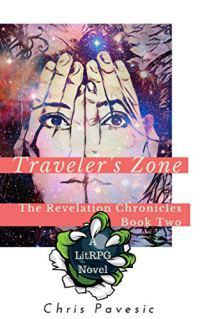
Above the tree line floats an airship close to three hundred feet long with a slightly rounded wooden hull. Ropes attach the lower portion of the ship to an inflated balloon-like aspect, bright white in color with an identification symbol, a red bird with white-tipped feathers extended in flight, inside a round yellow circle in the center of the canvas. The deck is manned with archers and swordsmen. There are two sets of fore and aft catapults.
What I don’t see are cannons or any other type of a gun large enough to account for the sound of the explosion.
The ship pivots in the air, coming around to point directly at what looks like an oncoming flock of five large birds. Or creatures. They are too big and too strange looking to be birds. They drift closer, flapping their wings.
A moment passes before I realize that they are not creatures either. They are some sort of gliders. A person hangs below each set of the feathered wings, which flap and move with mechanical precision in a sky washed out by the morning sun.
The archers nock their arrows and aim at the flock.
The gliders draw in their wings and dive toward the deck, covering the distance in a few heartbeats. Most of the arrows fly uselessly past the attack force and fall like black rain from the sky. The archers aimed and released the volley too late.
The forward catapult releases a torrent of small rocks at the lead glider. It is a scatter-shot approach that proves effective. There are so many missiles that it is impossible to dodge them all.
But at the moment the stones strike, the other four let loose with fireballs. Spheres of crackling flame spring from their hands, glowing faintly at first and then with increasing brightness. The balls of fire shoot from their hands like bullets from a gun and fly toward the ship, exploding. Pieces bounce off the hull and fall to the ground, throwing hissing, burning globs of magic-fueled fire in all directions, setting everything they touch aflame.
AMAZON BUY LINK SMASHWORDS BUY LINKWant to learn more about The Revelation Chronicles? Click HERE for updates on this and the other series by Chris. Watch the video on YouTube.
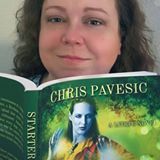
Chris Pavesic is a fantasy author who lives in the Midwestern United States and loves Kona coffee, steampunk, fairy tales, and all types of speculative fiction. Between writing projects, Chris can most often be found reading, gaming, gardening, working on an endless list of DIY household projects, or hanging out with friends.
Learn more about Chris on her website and blog.
Stay connected on Facebook, Twitter, and her Amazon Author Page.
February 22, 2021
Tell Again Tuesday Cover Your Book
CREATING A BOOK COVER THAT DOESN’T SUCKBy Author Anne Mitchell
If you’re a self-published writer like me, you’re probably always trying to work out ways to keep your costs down. Which isn’t, let’s face it, all that easy.
It’s vital not to skimp on numerous important aspects of the self-publishing biz, the gurus tell us. Editing, proof-reading, advertising, marketing – all these need appropriate investment. However, the thing we really, REALLY shouldn’t be skimping on, they warn, is the cover. On no account should . . .
For the rest of the blog go to:February 18, 2021
Friday Features Publications Journey
 The journey to publication wasn’t easy for me. In fact, it took me a great deal of time and effort to get to where I am now. So, let’s go back in time to 1995 when I got bitten by the writing bug during a Planning Your Novel workshop I attended for fun at the local college. One of the exercises I volunteered for still sticks in my mind. The teacher handed me three pennies, and I had to throw them into a waste basket one at a time. I managed to get all three coins in, shooting at different angles and distances. My teacher, Tom Arnett—a NYT bestselling author—was surprised at my luck because the norm was usually two pennies in. He explained that getting all the pennies in would suggest your (writing) goals would be too easy because the person threw them from a close distance. On the flipside, one penny in (throwing too far away) suggested having unrealistic expectations/goals about a career in writing.
The journey to publication wasn’t easy for me. In fact, it took me a great deal of time and effort to get to where I am now. So, let’s go back in time to 1995 when I got bitten by the writing bug during a Planning Your Novel workshop I attended for fun at the local college. One of the exercises I volunteered for still sticks in my mind. The teacher handed me three pennies, and I had to throw them into a waste basket one at a time. I managed to get all three coins in, shooting at different angles and distances. My teacher, Tom Arnett—a NYT bestselling author—was surprised at my luck because the norm was usually two pennies in. He explained that getting all the pennies in would suggest your (writing) goals would be too easy because the person threw them from a close distance. On the flipside, one penny in (throwing too far away) suggested having unrealistic expectations/goals about a career in writing.
You could say that this penny exercise set the bar for me, and gave me some hope in a field I knew absolutely nothing about. I ended up taking Tom’s night course, Starting your Novel, and from there the writing games began.
Trying to get published looked something like this:
• Write a book (I choose a paranormal romance) which took about 2 years, including research and learning the basics.
• Attended a workshop where I met an agent, and handed her a query and outline, which eventually got her interest. This went back and forth for a time (about four years) until the agent admitted that my book wasn’t developing the way she wanted it to go, so we decided to go our separate ways. Sigh.
• Around 1998, I had a dream where I saw seven arches, and there were seven people (five kids, two adults) with crystals in their hands, walking up to these arches. It definitely had an Indiana Jones feel to it. At that time, I was trying to get my paranormal romance published, and had no intention of writing in the young adult genre. But this idea kept growing in my mind, and wouldn’t leave, like some mystical force pushing me from behind. So, I thought I’d challenge myself to write a time travel series based on that dream, calling it The Timeliners, and later The Last Timekeepers.
• Had some luck with The Last Timekeepers when an agency and publishers showed interest. But their interest was short-lived. Rejection, rejection, and more rejection followed.
• In 2003, we sold our graphic trade business and house, packed up, and moved to our cottage in a popular tourist area located in Ontario. I decided to become a tutor for the local Literacy Council in the winter of 2004. While living pretty much off the grid (we had dial up internet), I started a teen psychic mystery series entitled, Mysterious Tales from Fairy Falls, pulling from my experiences living in the wilds of cottage country.
• I enrolled in a two-year correspondence course geared toward writing for children and teens to beef up my writing chops.
• Then, I decided to try my hand as a participant in the 2005 Muskoka Novel Marathon, where previously I had helped with the organizational aspects of this event. The idea is to write a novella or novel in three days, and the winner gets a chance at publication. During the course of the marathon, our dog died suddenly and I left for the day, only to come back the next day to finish writing my manuscript in time to submit it. It was truly a bitter-sweet experience.
 • My writing suffered after that, and I decided to enter the workforce as an animal care attendant at the local Animal Shelter for the next fourteen months. During this time, I finished my writing correspondence course, tinkered with Mysterious Tales from Fairy Falls, then finally woke-up and quit the animal shelter to get back to writing. I wrote a whole book out of my animal shelter experience, and geared it for my teen psychic mystery series. I sent in that manuscript and got rejected a lot, but one agent showed an interest. He later sent me a lovely rejection letter. Sigh.
• My writing suffered after that, and I decided to enter the workforce as an animal care attendant at the local Animal Shelter for the next fourteen months. During this time, I finished my writing correspondence course, tinkered with Mysterious Tales from Fairy Falls, then finally woke-up and quit the animal shelter to get back to writing. I wrote a whole book out of my animal shelter experience, and geared it for my teen psychic mystery series. I sent in that manuscript and got rejected a lot, but one agent showed an interest. He later sent me a lovely rejection letter. Sigh.
• Finally, in 2010, I decided to dust off my time travel story, update the characters and give it a fresh voice. I sent it out—mostly to agents—and got rejected again, and again.
• By this time, I had decided to check out ebooks and how to go about publishing them. Since I owned a graphics business for over twenty years, I had some business background, and it seemed many authors were being forced to wear two hats in these changing times. So I started a blog in May 2011 to create an on-line presence.
• Then, I entered the 2011 Muskoka Novel Marathon with the idea of doing the prequel for The Last Timekeeper series. Two writers there had just signed publishing contracts, so this gave me some hope. I asked if I could use their names as a reference when querying their publisher. They said, ‘No problem,’ but I’d have to wait until September to query. After the novel marathon, we all exchanged social media info.
• This is where hard work and opportunity collide. One of those writers shared a link on Facebook, which I thought was the publishing company she had signed with. But it wasn’t. It was the link to a new epublishing company calling for submissions. What the hell, there was nothing to lose while I waited for September to roll in. I sent out my query the end of August, and got a reply within seven days—Musa Publishing wanted to see my manuscript. Excited, yet not getting my hopes up, I sent my young adult time travel manuscript in. They loved it, but wanted revisions. Actually, they wanted a huge, big-ass rewrite that included making the entire book only in one POV, instead of the five I originally had written. Each kid had their own chapter. This publisher only wanted one kid per book. So they offered me five books right off the bat.
• I signed the contract September 13th, 2011, with a release date of May 18th, 2012. Plenty of time for rewrites, and plenty of time to learn what’s expected of an author in this new paradigm of publishing. I followed up with the prequel to The Last Timekeepers series, Legend of the Timekeepers came out in August 2013.
• Time travel to 2015 when Musa Publishing closed their doors permanently, and Mirror World Publishing appeared to open their doors for me. Not only did they take on The Last Timekeepers series, but in 2017 added Mysterious Tales from Fairy Falls to their young adult list of books. Woohoo!
Honestly, I’ve come a long way since 1995, and I’m still learning and growing in this crazy publishing business as it continues to evolve. Presently, I’ve got two young adult book series under my belt, both published through Mirror World Publishing. And I’d wager three shiny pennies that they won’t be closing their doors any time soon.
If you’re an author, what does your publishing journey look like? Did it take you a long time to get published? Would love to read your comments! Cheers, be well, and thank you for reading my post.
Here’s a glimpse of the premises of both my young adult series: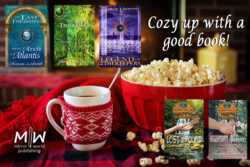
Mysterious Tales from Fairy Falls Teen Psychic Mysteries…
Imagine a teenager possessing a psychic ability and struggling to cope with this freakish power while trying to have a normal life. Now, imagine being uprooted and forced to live in a small tourist town where nothing much ever happens. It’s bores-ville from the get-go.
Welcome to Fairy Falls. Expect the unexpected.
The Last Timekeepers Time Travel Adventures…
Chosen by an Atlantean Magus to be Timekeepers—legendary time travelers sworn to keep history safe from the evil Belial—five classmates are sent into the past to restore balance, and bring order back into the world, one mission at a time.
Children are the keys to our future. And now, children are the only hope for our past.
The Last Timekeepers Time Travel Adventure Series:
The Last Timekeepers and the Dark Secret, Book #2
Buy Links:
MIRROR WORLD PUBLISHING ׀ AMAZON ׀ BARNES & NOBLE ׀
The Last Timekeepers and the Arch of Atlantis, Book #1 Buy Links:
MIRROR WORLD PUBLISHING ׀ AMAZON ׀ BARNES & NOBLE ׀
Legend of the Timekeepers, prequel Buy Links:
MIRROR WORLD PUBLISHING ׀ AMAZON ׀ BARNES & NOBLE ׀
Mysterious Tales from Fairy Falls Teen Psychic Mystery Series:
Lost and Found, Book One Buy Links:
MIRROR WORLD PUBLISHING ׀ AMAZON ׀ BARNES & NOBLE ׀
Blackflies and Blueberries, Book Two Buy Links:
MIRROR WORLD PUBLISHING ׀ AMAZON ׀ BARNES & NOBLE
 Sharon Ledwith is the author of the middle-grade/YA time travel series, THE LAST TIMEKEEPERS, and the teen psychic mystery series, MYSTERIOUS TALES FROM FAIRY FALLS. When not writing, researching, or revising, she enjoys reading, exercising, anything arcane, and an occasional dram of scotch. Sharon lives a serene, yet busy life in a southern tourist region of Ontario, Canada, with her hubby, one spoiled yellow Labrador and a moody calico cat.
Sharon Ledwith is the author of the middle-grade/YA time travel series, THE LAST TIMEKEEPERS, and the teen psychic mystery series, MYSTERIOUS TALES FROM FAIRY FALLS. When not writing, researching, or revising, she enjoys reading, exercising, anything arcane, and an occasional dram of scotch. Sharon lives a serene, yet busy life in a southern tourist region of Ontario, Canada, with her hubby, one spoiled yellow Labrador and a moody calico cat.
Learn more about Sharon Ledwith on her website and blog. Stay connected on Facebook and Twitter, and Smashwords. Look up her Amazon Author page for a list of current books. Be sure to check out THE LAST TIMEKEEPERS TIME TRAVEL SERIES Facebook page.
February 16, 2021
Wednesday Special Spotlight February Treats
I am a true romantic at heart, which is why I write romance books. So, of course Valentine’s Day is a special day for my husband and me. Today I want to share my pancake cups that are delicious any time during the year especially since I make mine with cherry pie filling. They are so light and sweet that they melt in your mouth. YUMMY!
1 cup milk6 eggs
1 cup flour
½ tsp. salt
1 tsp. vanilla
1 tsp. orange zest, optional
¼ cup butter, melted
Preheat oven to 400° F.
Blend the first 6 ingredients together with a hand mixer, and then add the butter very VERY slowly.
Grease muffin tins then fill them half-full with pancake mixture. Bake 15 minutes, or until fluffy and golden brown.
Once the cups have cooled, fill them with your favorite fruit. I prefer apple or cherry pie filling, but you could use pumpkin or blueberry.
Before serving, sprinkle a generous amount of icing sugar on top. I’ve sprinkled shaved dark chocolate on top of the icing sugar, but that’s just me. 
My latest murder, Til Text Do Us Part, is expected to release around the world by Valentine’s Day 2021. Grab a copy then sit back and nibble on some these tasty pancake cups. They are my favorite treat for February.
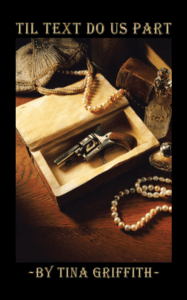 Louisiana Hobbs is an award-winning, murder mystery writer, and she has a malicious stalker. This person has been taking particular passages from the pages of her books, and has used the detailed information to commit chilling murders to perfection. But, has the stalker killed people out of revenge or as a form of flattery? While the author works closely with Detective Brody Anson to find the answer to that question, they develop an obsession for each other that becomes difficult to deny.
Louisiana Hobbs is an award-winning, murder mystery writer, and she has a malicious stalker. This person has been taking particular passages from the pages of her books, and has used the detailed information to commit chilling murders to perfection. But, has the stalker killed people out of revenge or as a form of flattery? While the author works closely with Detective Brody Anson to find the answer to that question, they develop an obsession for each other that becomes difficult to deny.
As the weeks turn into months, they have been trying to keep their surging desires in check…at least until the murderer has been put behind bars. But when Louisiana becomes the target in a dangerous game of cat and mouse, will this couple continue to withhold their true feelings from each other and the rest of the world?
 Tina Griffith, who also has thirty published children’s books as Tina Nykulak Ruiz, was born in Germany, but her family moved to Canada when she was in grammar school.
Tina Griffith, who also has thirty published children’s books as Tina Nykulak Ruiz, was born in Germany, but her family moved to Canada when she was in grammar school.
After her husband of 25 years passed away, she wrote romance novels to keep the love inside her heart. Tina now has thirteen romance novels on Amazon, and while all of them have undertones of a love story, they are different genres; murder, mystery, whimsical, witches, ghosts, suspense, adventure, and her sister’s scary biography.
Tina has worked in television and radio as well as being a professional clown at the Children’s Hospital. She lives in Calgary with her second husband who encourages her to write her passion be it high-quality children’s books or intriguing romance.
Stay connected with Tina (Griffith) Ruiz on her Facebook group Tina Speaks Out.

